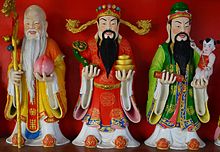
Back Tři hvězdná božstva Czech Fu Lu Shou German Fushoulu Spanish Les Trois Étoiles du Bonheur French Fu Lu Shou ID San Xing Italian Fu Lu Shou Malay Fu Lu Shou Dutch Fu Lu Shou Polish Sanxing Swedish
This article needs additional citations for verification. (August 2017) |
| Sanxing | |||||||||||||||||
|---|---|---|---|---|---|---|---|---|---|---|---|---|---|---|---|---|---|
 | |||||||||||||||||
| Chinese name | |||||||||||||||||
| Traditional Chinese | 福祿壽 | ||||||||||||||||
| Simplified Chinese | 福禄寿 | ||||||||||||||||
| |||||||||||||||||
| Vietnamese name | |||||||||||||||||
| Vietnamese alphabet | Phúc Lộc Thọ | ||||||||||||||||
| Chữ Hán | 福祿壽 | ||||||||||||||||
| Japanese name | |||||||||||||||||
| Kanji | 福禄寿 | ||||||||||||||||
| |||||||||||||||||
The Sanxing (三星; sānxīng; 'Three Stars') are the gods of the three celestial bodies considered essential in Chinese astrology and mythology: Jupiter, Ursa Major, and Canopus. Fu, Lu, and Shou (traditional Chinese: 福祿壽; simplified Chinese: 福禄寿; pinyin: Fú Lù Shòu; Cantonese Yale: Fūk Luhk Sauh), or Cai, Zi and Shou (財子壽) are also the embodiments of Fortune (Fu), presiding over the planet Jupiter, Prosperity (Lu), presiding over Mizar, and Longevity (Shou), presiding over Canopus. They have emerged from Chinese folk religion. Their iconic representation as three, old, bearded, wise men dates back to the Ming dynasty,[1] when the gods of the three stars were represented in human form for the first time. They are sometimes identified with other deities of the Chinese religion or of Taoism.
The term is commonly used in Chinese culture to denote the three attributes of a good life. Statues of these three gods are found on the facades of folk religion's temples, ancestral shrines, in homes and many Chinese-owned shops, often on small altars with a glass of water, an orange or other auspicious offerings, especially during Chinese New Year. Traditionally, they are arranged right to left (Shou on the left of the viewer, Lu in the middle, and Fu on the far right), just as Chinese characters are traditionally written from right to left.
- ^ (in Chinese) 福禄寿星 Archived 2006-07-22 at the Wayback Machine. British Taoist Association.